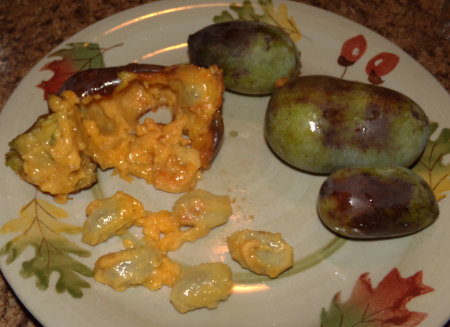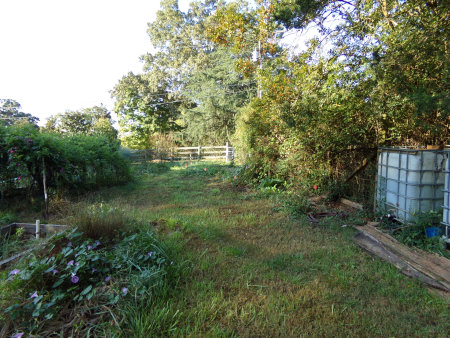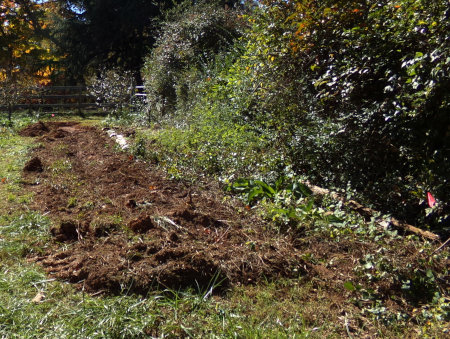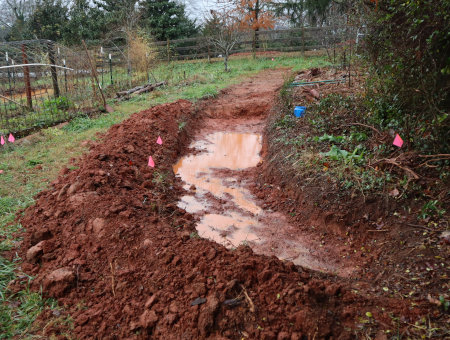Swale digging is on Dan's and my
winter project list. It's a subject we've been studying, so I wanted to
organize the notes here as a resource.
Notes from:
I. Definition - Swales are long, level excavations intended to capture surface
water runoff (from rain, roof, road runoff, tank overflow, diversion drains,
etc.) and then store it in underlying soils or sediments.
II. Function - to recharge groundwater systems.
A. To intercept and temporarily hold overland water flow.
B. Allow collected water to infiltrate into the downhill soil.
C. Nutrient delivery system, E.g. swales built under or next to a chicken
house can deliver nutrients from the manure via water flow to the rest of
the system.
D. Full effect will take several years to realize.
E. Can eventually recharge springs and aquifers.
III. Design planning
A. Ideal landscape - 15% of the ground surface covered in water
1. ponds
2. swales to transport water to the ponds
B. Design the system of swales and ponds for water to move:
1. by the longest path
2. over the longest time
3. with the least amount of friction
4. "The farther you lead water, the more storage you have."
C. Placement
1. Place first swale at the property's highest elevation possible.
2. Typically 4-6 feet below highest points
D. Begin the plan by marking the level contours of the property. This
will determine the pattern of the ponds and swales.
E. Spillways direct water flow from higher to lower storage features and
prevent overflow.
IV. Sizing
A. Varies greatly depending on soil and climate.
1. wider and shallower in sandy soils
2. narrower and deeper in clay soils
3. up to 6 m (20 ft) wide in deserts
B. Should allow for slow water movement.
1. The slower the better
2. Should be able to walk the speed of the flow.
C. Should be large enough to not blow out the spillways.
D. Width
1. Can be anywhere from wheelbarrow width to roadway width
2. should not exceed crown spread of fringing trees
E. Examples
1. Small, front yard size - 20 inches wide and 8 inches deep
2. Large, pasture size swales - 4-6 feet wide and 18 inches deep
V. Spacing
A. Swales typically hold moisture 30-40 feet down the slope.
B. Distance between swales can be 3-20 times the swale width depending on
rainfall.
1. Large swales can be spaced 12 feet apart with average rainfall
exceeding 50 inches.
2. Large swales should be spaced 60 feet apart with average rainfall less
than 10 inches.
C. On slopes, use height of trees to judge distance between swales, where
berms are level with the height of the treeline below.
VI. Construction
A. Built on contour, i.e they're level to allow even distribution of water
B. Equipment
1. Depends on size and budget
2. Can be dug by hand with shovels
3.
Tractor with turn plow, scrape blade, subsoiler, disc harrow
4. Backhoe
or excavator
C. Ground can be ripped first with subsoiler, for the planned width of swale
and berm.
D. Often dug into the subsoil
E. Material dug from the swale becomes the berm.
1. Berms not compacted or sealed (unlike pond walls)
F. Swale floor can be sloped to encourage water drainage in a particular
direction
G. Can be constructed to be backflooded by ponds
H. Spillways to direct overflow to another swale or pond in a series
1. lower than berm height
a. Geoff - 50-200 ml
b. Michael - 1/3 lower
2. can be packed clay, rocks, grass, concrete, anything that won't wash
out.
VII. Planting
A. Berm planting
1. essential for the long term functioning of the swale.
2. Seeded or planted on either side after an initial soaking of rain
a. grasses for grazing
b. perennial shrubs and bushes
c. Trees
i. Some of the collected water is stored in trees.
ii. Planted in the berm or above the swale (not in the swale)
iii. Essential in arid climates to shade and reduce evaporation
iv. Roots increase absorption efficiency
v. Leaf drop adds nutrients and organic matter to the swale
B. Swale planting
1. Since the topsoil is removed, the swale itself is not typically fertile
a. soil can be left to accumulate organic matter
b. can be planted with grass
c. can be filled with mulch or gravel
VIII. Living Swales (Michael)
A. Living swales are planted swales, not earthwork swales
1. constructed on contour of dense, clump grasses such of vetiver
2. the grasses stop and retain overland water flow, similar to dug swales
3. common in regions with shallow or rocky soils
B. Over time, earthwork swales will fill in with plant and runnoff debris,
and the planted berms will create living swales.
~~~
When I started organizing my notes into an outline, I didn't realize how many of them I had. A lot! So this turned into a larger job than I anticipated. Still, to have what I've learned organized and easy to access feels good.
Next time, I'll show you our plan to, hopefully. put this information to good use.
































